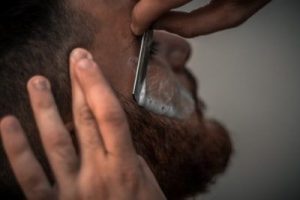Hair loss, gradual hair loss or thin hair, what to do

Thinning hair, gradual hair loss or hair loss, what to do?
Slowly thinning hair does not seem to be as worrying as severe diffuse hair loss. Nevertheless, the gradual thinning of the hair is also based on hair loss, androgenetic hair loss.
Before the hairs can become strong terminal hairs, they fall out. The hair loses volume, becomes greasy quickly and the scalp shimmers through. Read more about the causes.
What is androgenetic hair loss?
Hair follicles on the top of the head are very sensitive to DHT, a derivative of the male sex hormone testosterone. This sensitivity is genetically programmed. Hair falls out early.
Although the hair grows back, the over-rotated hair cycle prevents the very fine, sometimes downy hair from becoming strong and long-growing terminal hair.
Hair loss triggered by the androgen DHT results in androgenetic alopecia; alopecia stands for hairlessness.
Two androgenetic relapses in men
Androgenetic hair loss goes through two major stages. In young men, the first episode around the age of 20 marks the beginning of hair thinning, and very often the formation of receding hairline and tonsure.
The second androgenetic surge around the age of 40. After the age of 50, often earlier, the hair will most likely continue to thin out, so that baldness can occur.
Look into the future
The androgenetic hair loss can be more severe as well as less severe compared to brothers, father and grandfathers. Depending on individual genetic predisposition, this process lasts a few years or several decades.
Looking at their male relatives, young men can roughly estimate how their hair thinning or gradual hair loss will develop. gradual hair loss will develop.
Thinning hair in women
Even women are not spared from androgenetic hair loss. Approximately one in five women is affected. The gradual loss of hair appears much more slowly in women than in men.
Hair thinning can be very discrete and can be mistaken for diffuse hair loss.
The hair does not decrease, but it does not reach its full length, because the growth hormone estrogen cannot develop its full effect.
With good styling products and the right hairstyle, it is possible to visually conceal the slightly thinning hair for a long time.
Decreasing hair density during menopause
If the hair follicles have to be treated beforehand or. At the beginning of menopause, with practically no growth hormone estrogen, hair formation at the hair roots is disturbed to such an extent that the hair follicles end the growth phase within the hair cycle and fall out.
In contrast to men, gradual hair loss in women is not noticeable in the vast majority of cases in the receding hairline of the forehead and the back of the head. Hair thinning in the crown area in women.
No complete hair loss
Finally, the lack of estrogen results in a relative predominance of androgens. The hair that grows back is then under the constant influence of DHT and miniaturizes or stops hair production to such an extent that the density of the hair decreases significantly once again.
The other hairs look healthy and are healthy because their growth is not disturbed by DHT. As a rule, androgenetic hair loss in women does not lead to complete hair loss.
Remedies for thinning hair
Fortunately, there are a handful of agents, some over-the-counter, some prescription, that can slow or stop hair thinning and even stimulate new hair growth.
Since agents that stop thinning hair due to androgenetic hair loss must be used permanently, it is important to use a very effective yet tolerable agent without side effects.
Active ingredient thiocyanate
An alternative to hormone-containing products is Thiocyn hair serum, which is based on the natural molecule thiocyanate and is applied topically.
Treatment with the patented thiocyanate active complex leads to measurable success in both women and men with thinning hair.
Massaged into the scalp once a day, thiocyanate strengthens the hair roots in the long term and protects them from growth-disturbing influences, so that hair density is increased by up to 35% after 9 months of use.*
* clinical dermatological application test over a 36-week period, 20 subjects with hair loss (10 women, 10 men), dermatest Research Institute, 2016




